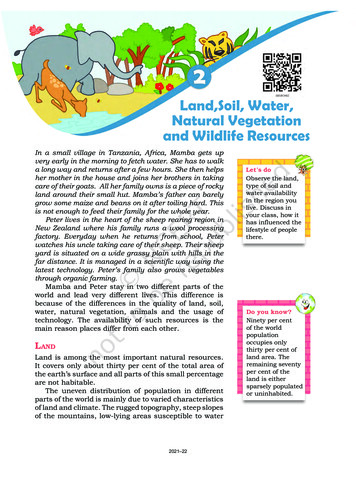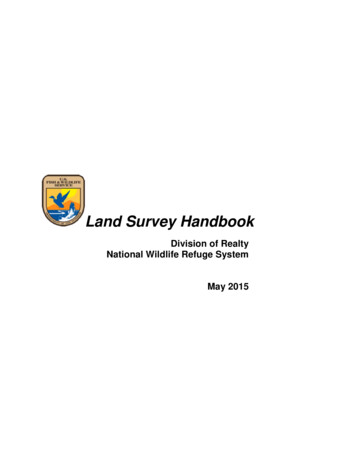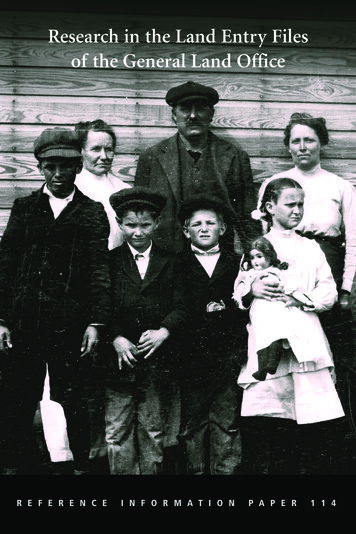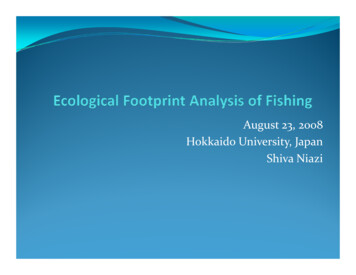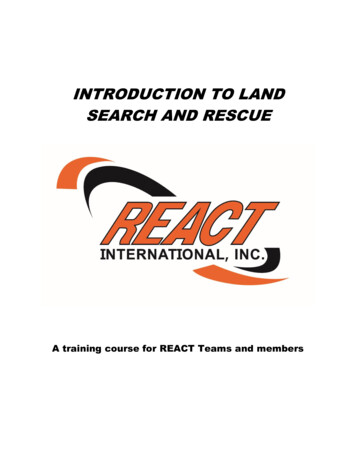
Transcription
INTRODUCTION TO LANDSEARCH AND RESCUEA training course for REACT Teams and members
This is a revised edition of Search Teams, a 1992 REACT InternationalCourse. It has been updated to reflect changes in search and rescue inCanada and the United States in the years since its original publication,while retaining the mission of the original course as an introduction forREACT Teams to the basics of land search and rescue.Author: Walter G. Green IIICopyright 2017 by REACT International, Inc. All rights reserved.REACT International, Inc.P.O. Box 21064, Glendale CA 91221e-mail: Training@REACTIntl.org(866) 732-2899 / Toll Free (US Only)(301) 316-2900 / International(800) 608-9755 / FaxREACT Introduction to Land Search Course2
Table of ContentsI.IntroductionPage 4II.Search is an EmergencyIII.Activating the Search and System12IV.If You are First on Scene17V.Basic Search Theory20VI.Search Tactics23VII.Interviewing32VIII.The Search Team in the Field36IX.Runaway and Abducted Persons43X.Direction Finding46XI.Logs52XII.Developing a Search Capability in Your Team547REACT Introduction to Land Search Course3
I. INTRODUCTIONThis course was first developed in 1992 to meet a need for basic search and rescuetraining for REACT team members who respond to search events. If you completedthe old Search Teams course, you will recognize much of this material. However,in the 25 years since its original publication, search and rescue has evolved in theUnited States and Canada into a very capable emergency service, and this text hasbeen completely reworked to address the changes,Normally our role in REACT is communications, but sometimes the need is not somuch for radio operators as it is for people who can walk across a field or down aroad or around buildings looking for someone who is missing. Because you are amember of an organized team, you know how to work as a team, follow a teamleader, and carry out a task. Untrained volunteers who simply show up in responseto a public appeal do not have those skills. So, whether the task is searching for amissing person, trying to locate an emergency beacon, or supporting other teams ascommunications liaisons, you can be a valuable resource.Before you take this course, there are some things that you must commit to memory.We are going to cover these points in more detail, but they are worth stating at thestart because they provide a basic guide as to how to be a good citizen in the searchand rescue community.1. You are not in charge. The responsibility for search and rescue lies withthe Air Force, the Coast Guard, elected and senior appointed government officials,emergency management agencies, and law enforcement. You work for (first) theincident commander and (ultimately) the missing or lost person or persons.2. Know the incident command system. Understand that the way localagencies apply the incident command system is not necessarily by the book. Adaptto the procedures and organizational structure the local authorities use.3. The way to get used is to talk to the responsible organization for searchand rescue in your community before there is a search, establish your credentials,find a need that you are capable of filling, take the standard training other agenciestake, and if there is a certification program, become certified – in other words dowhat all the other organizations have already done. When you are called, respondquickly, play nice, do what you are asked to do, and stay the course.4. Accurately represent your training, experience, or capabilities. Be humble,but also be able to do what you say you can do very well and to a professionalstandard.REACT Introduction to Land Search Course4
5. Offer your services before you respond. If you are told “no thank you,”don’t go. No search manager wants to deal with an organization he did not request,whose capabilities are an unknown, and to whom he now must assign someone tokeep the unknown team from getting in trouble. Do not self-dispatch.6. When you respond be in uniform, look good, be calm, and actprofessionally. People have confidence in uniformed, professional responders. Thatconfidence helps you in dealing with the public.7. Do not freelance. If you are assigned to do a task, carry out yourassignment. Do not wander off and do what you want to do, rather than what youare told to do.8. REACT members working on a search have no greater powers or authoritythan any other citizen. You may not enter private property without the owner’spermission, take people’s belongings that might help your efforts, or give orders tothe general public, government workers or officials, or emergency responders.9. Don’t play with stuff, your stuff or other people’s stuff or things you findin the search area. Stayed focused on the task. Don’t pick up and handle evidence– flag it and report it.10. Maintain accountability. Know where all of your team members are allof the time. No one goes anywhere alone. Make sure the appropriate managersknow where your team is, what task it is working on, and what its status is. Whenyou finish report back your results. When released, account for your people, andmake sure to check out with the appropriate people.11. If you think it might be unsafe, believe it – it is unsafe. The doubt in yourmind is the signal that you are about to do something stupid that could get you hurtor killed. If you are injured, or worse yet killed, as part of a search, you become partof the problem, not part of the solution.12. Refer all requests by news media to interview you or your team to theincident public affairs officer. Period.13. Afterwards, when you speak to others about the incident, do not criticizethe agency of the individuals who managed it. The time for questions about whysomething was done, or suggestions on how to do it better, is the debriefing or thehot wash. There is never time for complaining or ego. If you speak publicly againstthe incident’s managers you may get a lot of attention, but your team will never beused again.REACT Introduction to Land Search Course5
Remember that this course will not make you an expert in how to do land search andrescue. It is an introduction. Get to know the search and rescue teams in your areaand state, ask how you can help, attend their training, work with them in exercises,and be a reliable partner in actual responses. If you do, you will make a realcontribution to helping find people who have misplaced themselves in the urban,rural, or wilderness environment.Training Note: If your team is using this course as a training program in yourmeetings or a training session, we have included short discussion topics andpractical exercises at the end of each section to help focus your learning. Haveyour members read the material and then discuss or walk through these itemstogether in your training session.Terms and Abbreviations: One standard abbreviation is used throughout thiscourse – “SAR” is the accepted short version of “Search and Rescue.”REACT Introduction to Land Search Course6
II. SEARCH IS AN EMERGENCYAny SAR incident is an emergency. This means that any report of an overdue ormissing person must be treated with as much seriousness as a report of a school busaccident, multiple vehicle collision, tornado, flash flooding, etc. One or morepersons’ lives may be in danger – the subjects of searches are often found dead,injured, or ill, and some are never found.At the same time, it is important to understand that, as a member of a REACT team,that searches can create intense news media and public interest and political pressurefor a quick and successful outcome. Bungling a search can create very significantnegative outcomes, and even possibly legal liability, for your team.Let’s review the timeline we find in the start of any emergency response.the event happensemergency unit alertedresources respondcontrol efforts startand arrive on sceneit is detected and reported1. EVENT – the event that causes the emergency situation may be animmediate, acute happening, or it may be a chronic event that gets slowly worse overtime. In the cases of searches for depressed, disturbed, or ill people, it oftenrepresents a chronic condition. On the other hand, a hiker falling, a child getting offthe bus at the wrong stop, or a vehicle breaking down in a remote area is a rapidonset acute event.2. DETECTED – from the emergency response system’s perspective, if noone realizes that someone is missing, then no one will look for them. Somedetections are easy – a three car accident with injuries in front of a fire station whenthe engine company is in quarters, for example. Some are harder and are delayed –for example, a person who goes missing on the first day of a three-day weekend maynot be identified as missing until someone from her work calls on the second dayshe is absent from her job.3. REPORTED – an incident can be detected, but not recognized andreported. Someone might decide that he does not want to get involved or that it isREACT Introduction to Land Search Course7
none of his business. A driver who sees a ripped-out section of guardrail couldbelieve it to be an old accident site. A vehicle down an embankment has probablyalready been reported, so why overburden the public safety answering point with yetanother call about something they already know? Reports of missing or lost personscan be made to a variety of different agencies, each of which may respond to suchreports in a different way and with a different sense of urgency.4. ALERTED – at some point the agency which receives the report may alertregular emergency response and/or search and rescue units. This may be in terms ofminutes for a public safety answering point (a 911 center) or hours or days for amissing person report to a police department or a report to an agency that does notnormally perform emergency responses.5. RESPOND – and then the responders have to respond. Fire, police, andemergency medical services response to an emergency incident is measured inminutes. If the missing or lost person is not perceived as an emergency, there maybe a considerable lag between the alert and the response, especially if the agency isunderstaffed for its normal load of emergency calls. Response by volunteer searchand rescue groups is typically initiated immediately on being alerted, but it takesthese organizations longer to get out the door because members work and have tonotify people, rendezvous at their equipment cache, start accountability, loadvehicles, etc. Thirty minutes is a fast response under these conditions; one to twohours may be realistic.6. ARRIVE – in a city, fire and emergency medical services are expected toarrive on scene within 5 minutes of being dispatched by their dispatch agency. Theirresponse areas are designed to give this speedy response. In search and rescue casesresources may come from across the state. If you have been asked to respond to asearch in a wilderness area, travel time may be hours. Road conditions, other traffic,the need to refuel vehicles in route all delay arrival.7. START – once you are on scene, you don’t simply climb out of yourvehicle and rush off to search. Much as a fire officer climbing out of his engine hasto assess the scene and make a quick initial attack plan or a paramedic has to assessthe scene and the patient, you have to establish command, report on scene, make aquick plan, assign people to tasks, etc.This is a complicated timeline with a lot of parts, any one of which can substantiallyimpact whether or not a missing person who was living when they went missing isREACT Introduction to Land Search Course8
found still alive. Four specific factors combine to make an emergency responsenecessary.LAG IN THE RESPONSE SYSTEMThe timeline we have identified means that there will always be a lag between aperson actually becoming lost or missing and the time that the search starts. Howlong that lag is depends on how much of the missing person’s time each stepconsumes. Anything you can do to reduce the time required has the potential tomake a positive impact on the outcome. However, in the process do not take unsafeactions or actions that have the potential to overlook critical information in the questfor speed.The first three steps, event, detection, and reporting, are often critical, but they arethe part of the time line over which you have the least control. There may be a longdelay between the time someone goes missing and the time he or she is reportedmissing. Family and friends may assume the missing person is late or has divertedto some other activity. Parents of missing children may organize family, friends,and neighbors for an improvised search and work for several hours before callingfor help. Finally, when the expected time of return for a boater or hiker is well past(midnight is common), the realization sets in that the person may be lost. If theindividual does not have anyone waiting for them at home, the understanding thatsomething went wrong over the weekend may not come until the start of work onMonday. As a result, SAR response often does not start until hours or even daysafter the actual event.VICTIM SURVIVAL LIMITATIONSChances of finding a missing person alive in a search drop rapidly. Historical datashows that 50% of the living victims are found in the first 24 hours; over 75% arefound in the first two days. There are many cases of lost persons surviving extendedlengths of time, sometimes because conditions were good, sometimes because theindividual did the right things to actively work to survive, and occasionally in spiteof what the person did to get in trouble. But your chances of finding them and theirchances of surviving are better if you find them as soon as possible after the incidentoccurs.A number of factors contribute to the threat to the missing person’s survival:REACT Introduction to Land Search Course9
1. Injuries – the individual may be lost because they are injured or they maybecome injured in their efforts to self-rescue from the situation.2. Weather – a substantial number of incidents involve bad weather. Coldweather and rain increases the risk of hypothermia. Hot weather increases the riskof dehydration and heat illness. And bad weather of any type makes travel moredifficult and dangerous.3. Unprepared people – search and rescue statistics in some areas haverecorded a doubling of search and rescue cases in the last decade. A low level ofsurvival awareness and outdoor skills in an increasingly urbanized populationcontributes to this. Rescuers now routinely respond to people who have not plannedtheir route or consulted weather forecasts, have inadequate clothing for conditionsthat could be reasonably expected, have inadequate equipment for the activities theyare undertaking, and expect that rescue will be immediate, summoned by cell phone.LIMITING THE SEARCH AREAAn adult male in good condition and experienced in outdoor travel hiking throughopen forest on generally flat terrain can travel approximately 2 miles in an hour.This means that the theoretical search area at the end of that hour is approximately13 square miles. If he hikes for 2 hours, the area expands to almost 50 square miles.One of the searchers’ priorities must be to keep the possible search area fromgrowing, and to use clues and information to actually shrink it.Three factors reduce the search area before you even show up to search. First,natural or man-made features may restrict the direction and speed of travel. Forexample, if our hiker was hiking along the side of a lake that covers half thetheoretical search area, we would “only” have to search approximately 6½ squaremiles.Second, there is a large body of data that gives search managers a very good start atunderstanding lost person behavior. The bookstore run by dbS Productions(http://dbs-sar.com/Books/Books.htm) includes a variety of lost person behaviormaterials that reflect the current state of the art. This research helps restrict anddirect search efforts to the highest probability areas.Third, the missing person may have helped restrict the search area. If he or she toldsomeone their destination or route, this provides a starting point for search efforts.REACT Introduction to Land Search Course10
Any evidence left behind by the missing person may be a vital clue in determiningthe where of the search problem and in limiting the initial search area.INFORMATION IS FRAGILEA key to finding the missing person is locating clues that help you establish wherethey have been and where they are going. Clues are very perishable. Witness whomay have seen the person may leave the area and never realize that a search isongoing for the person they saw. Memories of things heard or seen may fade or bechanged by publicity about the search. Tracks may be destroyed by other persons,animals, vehicles, rain, etc. Scents disperse making tracking by dogs more difficult.Disturbed vegetation may return to its normal position. Items the person drops, suchas clothing, backpacks, or children’s toys, may be picked by others and taken away.A quick response increases the potential for locating these clues.Safety Alert: Although we are emphasizing that search is an emergency, theoperating principle is make haste slowly. Drive defensively, watch out for otheremergency vehicles, park where you do not block access or egress, think beforeyou act, consider hazards, move deliberately, and pay attention when someonesays “this is dangerous” or “this makes me uncomfortable.” Don’t become part ofthe emergency.For Discussion:(1) Do you remember a recent search for a missing person in your area? Did anyof the four factors above play a part in the incident?(2) Given the timeline in this chapter and the factors that make an emergencyresponse necessary, what steps can you take to speed up your team’s response?(3) When you talk to people about emergency preparedness, what are some topicsthat you could emphasize that they should do to help searchers if they are missing?REACT Introduction to Land Search Course11
III. ACTIVATING THE SEARCH AND RESCUE SYSTEMThe SAR system is a combination of Federal, state, local, and volunteer agencies,with a common approach to emergency operations, and the procedures, facilities,and people needed to search for, locate, provide emergency care, extricate, andrecover those who are lost or missing. To understand the big picture of how the SARsystem works, you need to be familiar with the Incident Command System and theNational Response Framework (a good source for this knowledge is completing theFederal Emergency Management Agency Independent Study Courses IS-100, IS200, IS-700, and IS-800).To activate the SAR system someone with knowledge of an emergency must contactan organization with search and rescue responsibility. These organizations varybased on the law in each state. However, in general, the following guidelines apply: On the navigable waters of the United States, including coastal areas, theGreat Lakes, and major rivers: Any US Coast Guard station State marine police Local jurisdiction water rescue agency (typically a fire department orpolice department) For an incident within a National Park – the National Park office (US NationalPark Service). For an incident with a National Forest – the National Forest office (USNational Forest Service). For a missing or lost person on land or on local bodies of water – the lawenforcement agency of the local jurisdiction, typically the sheriff. For a missing aircraft – any manned facility of the Federal AviationAdministration, including a control tower, flight service station, or air routetraffic control center. For a presumed or reported aircraft crash – typically the state police.REACT Introduction to Land Search Course12
If you are unsure or cannot reach the appropriate agency directly, call yourpublic safety answering point, usually found at 9-1-1.Although the above list is based on United States public safety and emergencyservices practice, the same principles apply in most nations, although the specificagencies that have responsibility for managing searches will be different.Often the person making a report of a missing or lost person will not know how toget help. They will call the agency or person in their community most accessible tothem. That may be a call for help on a CB, GMRS, FRS, or amateur radio. It maybe someone who knows that you do emergency response work. Or it may besomeone who runs into you in a frantic search in a park for a missing child. It mayeven be a social media post. As the first point of contact, your actions are crucial toa successful rescue. You are now part of the SAR system; you must pass their reporton to the appropriate agency, accurately, completely, as quickly as possible.FIRST - TREAT THE SITUATION AS A SERIOUS MATTERLet the person making the report know that their report is important. This establishesyour good faith. If the missing person is found dead or seriously injured, your takingthe initial report seriously may help alleviate some of the reporter’s concern as towhether they did the right thing.SECOND - GET NAME, ADDRESS, AND PHONE NUMBERYou must be able to get back in contact with the person making the report if you orothers need more information.THIRD - GET EVERY BIT OF INFORMATION YOU CANIf you receive a report that may trigger a search incident, it is vital that you gatherand record as much information as practical about the missing person, and thenprovide that same information verbatim to the agency you contact. The standardquestions that news media reporters use to gather information for their storiesprovides a good way to organize your information gathering: WHO – who do we need to look for: the number of persons missing their names, ages, and genderREACT Introduction to Land Search Course13
physical description with clothing and shoe size and type physical condition, mental state, or medical condition description and type of their vehicle, aircraft, or boat, including colorand registration any survival training or equipment that they may have any signaling equipment that they may have WHAT – were they doing? what was the activity in which they were participating what was their destination what was their proposed route of travel what were weather conditions like at the time WHY – were they doing what they were doing? was it business or pleasure were there alternate activities that they could have engaged in and thatwould have changed their route WHERE – where was the missing person last seen? where was the person, aircraft, boat, or vehicle last seen what were the conditions at that time was the person making the report the last person to see him or her did the person making the report watch the person until they were outof sight WHEN – are the key times? when did he or she depart when were they supposed to contact the person reporting when were they supposed to arrive or return when did the person making the report last have contact with themThese are by no means all the questions that may need to be asked. Someinformation has to be gathered from friends, coworkers, or persons the victimdid business with rather than from the family. However, the family of the victimknew that person best and is usually very cooperative in supplying information.Try to get as much information as possible early in the search to improve yourchances of finding the victim alive - ask!REACT Introduction to Land Search Course14
Some questions are best asked by trained investigators in follow-up interviewsbecause of their potential to upset the family or to cause the individual making thereport to disengage. Asking if the missing person might have run off with an illicitlover, was suicidal, or was engaged in illegal activity may fall in this category.Always end with the question: “Is there anything else that you can think of that mighthelp us find (insert the person’s name)?”FOURTH - MAKE SURE THEY CAN CONTACT THE SAR SYSTEMIt is possible the person who makes the report may remember something that he orshe did not tell you the first time. Or it is possible that the missing person makescontact with them 20 minutes after they make the initial report. Give them the nameof the agency you will pass the report to and its phone number, and let them knowthat someone from that agency may contact them for more information.FIFTH - CONTACT THE AGENCY WITH SAR RESPONSIBILITYTurn the problem over as quickly as possible to the agency responsible forcoordinating searches in your area. Don’t try to run your own private search – youmay not have all the facts, the problem may be significantly different from what wasreported to you, and you may confuse rather than help the situation.SIXTH – IF APPROPRIATE, OFFER ASSISTANCEIf you have a team that can respond, offer your assistance. If you offer, make sureyou can do what you offered – be realistic. If your team has 8 members, all of yourmembers work, their employers do not have a liberal emergency response policy,and it is 2:00 pm, don’t tell the coordinating agency that you can have 15 peoplethere is 15 minutes. Offer to have a team available at 6:00pm with five trainedsearchers. If the agency says “yes, we need your help,” respond with what youoffered. If they say “no, we have other resources,” you have still performed a criticalfunction in this search by alerting the system to the emergency.Learning Activity: Identify the agencies in your jurisdiction that have search andrescue responsibility – and get the 24 hour alerting numbers for reporting a searchincident to them.REACT Introduction to Land Search Course15
For Discussion: Have your members take turns reporting a missing person to theother members taking this training. If possible use details from actual searcheswith which you may be familiar. Have the members receiving the report completethe steps described in this lesson to activate the search and rescue system.REACT Introduction to Land Search Course16
IV. IF YOU ARE FIRST ON SCENEIn any emergency incident there are several basic steps that responders take to startto gain control of the incident and set the ground work for as successful an outcomeas possible. These equally apply to searches.FIRST – PARK YOUR VEHICLEPark your vehicle? Really? Yes, but where is the important thing. Park your vehiclewhere it will not block access for emergency vehicles, and where you have areasonable chance of being able to drive away when you are demobilized or if youneed to move to another assignment. Yes, you want to get as close as possible to thestarting point of your search, right up there where the witness is waiting for you. Butif that is up a one lane road with no room to turn around, you will be there until thelast vehicle that parks behind you leaves.SECOND – ESTABLISH COMMANDThe Incident Command System expects the first officer or team leader on scene toassume command and start to manage the incident. You assume command by yourteam leader clearly stating “your team name assumes command.” When you reportto the coordinating agency that you have assumed command, include the incidentname and where you are. Incoming resources will expect to find an incidentcommander, even if it is only to relieve that commander with a more qualifiedincident commander or with an incident commander with the appropriate legalauthority.THIRD – CONDUCT A SIZE-UPWhat do you have, where is it located, what witnesses are available, what do theyknow, what have the people on scene already done, what are the hazards. Resist theimpulse to jump out of your vehicle and immediately rush into action. Take the timeto get an initial grip on the problem. This should not be a lengthy process, two tothree minutes should suffice in most incidents.FOUR – IDENTIFY WHAT RESOURCES ARE NEEDEDUnlike in fires or mass casualty incidents where the first due unit can follow wellpracticed department procedures to order a second or third alarm or a mass casualtyresponse, you probably will not be able to make a good guess as to the eventualREACT Introduction to Land Search Course17
number of search resources needed. But you probably can identify that you willneed a trained incident command team to manage the incident, make an initialestimate of the number of search teams you will need, and determine if the situationwill require water rescue, technical (vertical rescue), etc. resources.FIVE – REPORTContact the coordinating agency and provide an initial report. The following is anexample: High Country REACT has assumed Beavers Trace command. [assumption ofcommand] We are located on Beavers Trace approximately one quarter mile north ofState Road 422. [where you are] We have made contact with the Jones Family and they report that the fatherand the 10 year old son departed this morning to hike up the trail to Sunsetlookout, and have not returned. They and two other campers went up the trailbut have been unable to locate the two missing persons. [the size-up] We need a search incident command team with a qualified incidentcommander, a dog team, and at least three additional search teams. [resourcesneeded]SIX – START TAKING ACTIONSMake a quick plan for initial search actions. Assign team members to specific tasksand start search actions. Start a log and record which members are assigned to whichtasks, what the results are, clues found and new information received, etc.SEVEN – BE READY TO HAND OVER COMMANDWhen a more experienced and better qualified incident commander arrives, be readyto hand over command. To transfer command:1.Brief the incoming incident commander on what has happened to thispoint in the search. Include: What you know about the missing person What happened before you arrived as related to you by people whowere on the scene when you assumed commandREACT Introduction to Land Search Course18
Your initial action planWhat re
REACT Introduction to Land Search Course 6 Remember that this course will not make you an expert in how to do land search and rescue. It is an introduction. Get to know the search and rescue teams in your area and state, ask how you can help, attend their training, work with them in

